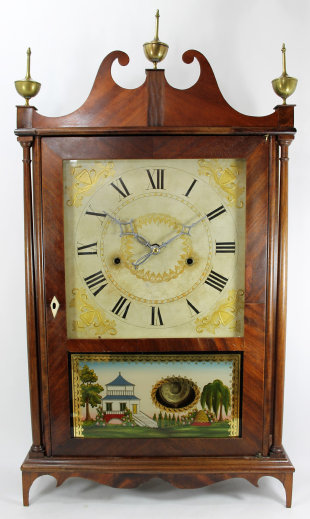
613. $300
Early weight-driven banjo. A 35-inch mahogany case with flame mahogany front boards. The throat board is split. There is no label or signature on the case, dial, or movement that we can find; the painted dial
is attached to the movement with four screws as a tall-case clock dial would be attached to a movement. There is a heavy thick
glass in the heavy brass bezel. The hands appear original. The weight-driven movement and pendulum are typical of banjos;
there are some oxidation spots on the bob. The weight is on a brass pulley behind a tin weight shield that seems to be original
(all the screw holes line up); for that matter, there are no additional dial holes or movement mounting holes. The 8-day time-piece
is running easily and keeping time. The wood finial on top may or may not be original, but it appears that there should also
be a finial on the unusual round bottom piece. All in all an atypical early banjo, but we are not banjo experts. The flame
mahogany case is nice for sure. $400-$1200.
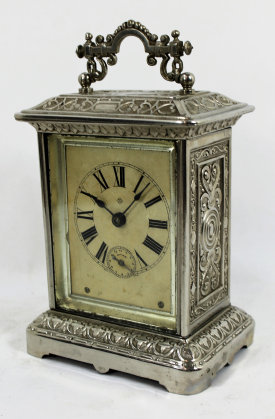
614. $100
Ansonia “Carriage Extra” in nickel, ca. 1904. This is one of the larger carriage clocks, 6.5
inches high with the handle down. The dial is glossy paper, slightly yellowed, with an inset alarm dial. The hands are
correct. The nickel case is in nice shape, needing only a bit of polish; no nicks, dings, or dents that I see. The nickel
back door opens to a backwind time, alarm, and half-hour strike on a bell under the base. The strike is off by 15 minutes so
you will need to open the case and reposition the minute hand. The clock runs for a while and then stops. It’s only a
one-day clock anyway. These generally sell for around $150 on eBay when found in nickel. $125-$175.
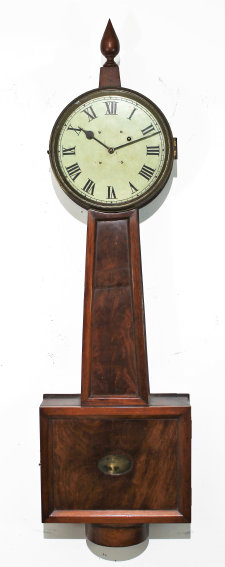
615. $150
Russell & Jones Clock Co. “Berkshire Drop”, 1890-1893. Arising briefly from the remains
of the Terry Clock Co., this duo offered a variety of clocks before disbanding in 1893. The Berkshire Drop differs in design
from year to year but offered a thermometer and level in distinction to their other models. The level at the bottom of this
clock is working, not commonly seen. The thermometer is a replacement. The 28-inch case is walnut with a lacquer finish,
the front glass is new, and the dial paper replaced. The pendulum bob and hands are correct. The 8-day, time and half-hour
strike signed movement is running, striking on a wire gong. There is also an alarm which is not hooked up. A dark label
on the bottom. The bottom-most piece of the base has been broken and repaired more than once. $225-$275.
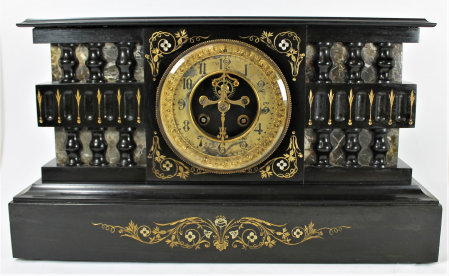
616. $75
French black marble mantel, ca. 1900. A 38-lb marble (Belgian slate, really) mantel clock, 16
inches wide and 9 inches high. There is a mottled marble front behind short marble double-columns with gold and silver incising
along the bottom and around the dial. The painted dial shows considerable wear; there is a beveled glass in the brass bezel. Brass hands and an outside escapement. No chips, scratches, or discolorations to the case. The round unsigned French movement
is not running although the springs are fully wound. Clock looks great but you’ll need to do some work to get it running. $125-$175.
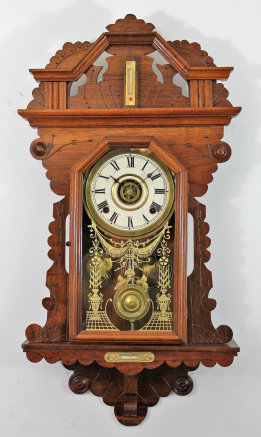
617. $200
Seth Thomas Empire No. 64 crystal regulator, ca. 1908. A higher-end crystal regulator
from Seth Thomas, with heavy beveled glasses all around (the rear door glass is chipped in one corner), fluted columns on all four
corners and a faux marble finish applied to the base and underside of the top. The one-piece porcelain dial is decorated with
garlands of flowers and is clean and flawless. The hands are correct. There is an 8-day round movement with a half-hour
rack strike on a suspended cathedral gong; it is running and striking without issue, keeping time. There is a two-jar faux mercury
pendulum. The gold finish on the 11.5-inch tall clock is in excellent shape; perhaps just a touch of polish if you are really
fussy. The faux finish would appear to be a factory special order, as it is appears to be quite resilient and impervious to
nicks and scratches. I like the look of this clock. Not many sales in the Antique Clocks Price Guide, the most recent
being at Schmitts for $225 in 2015. It lacked the faux marble finish on the base and top. $250-$500.
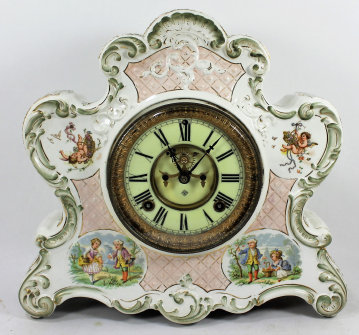
618. $175
Porcelain clock with Ansonia movement, ca. 1900. This is a very nice porcelain clock with putti
in the upper corners and pairs of children depicted on the lower left and right. It holds an Ansonia 8-day time-and-strike movement
but that is not the correct movement; this is probably a British or German clock. It stands 12.5 inches high with good color
and no chips, crazing, or cracks. There is a signed Ansonia porcelain dial and an outside escapement that is running and striking
appropriately. The bezel could use some polish, but that is about the only issue; it holds a beveled glass. $225-$350.
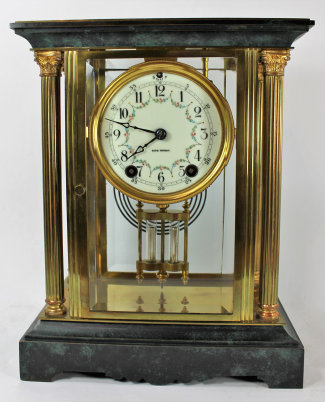
619. $100
Ingraham “Crown”, ca. 1900. Bless their heart, someone put a New Haven movement and dial
in an Ingraham case. There is a label on the back of the 27-inch refinished walnut case, which, if you read closely indicates
that the clock was made by Ingraham. There is a working level at the bottom, an old decorated glass, and a New Haven-signed
paper dial and 8-day time-and-strike movement, running and striking on a wire gong. A large single-barrel pendulum; looks like
there should be a thermometer at the top. A nice-looking marriage. $150-$250.
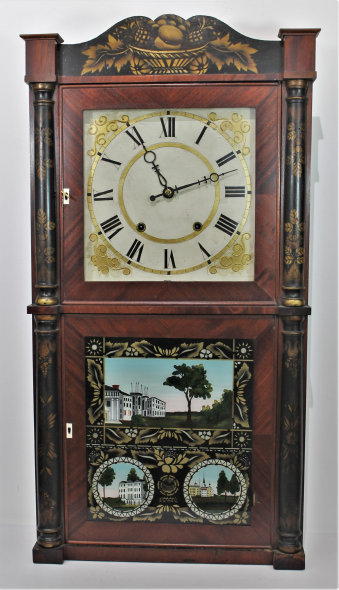
620. $300
Henry Terry Eight-day Column & Splat shelf clock, 1825-1835. This son of Eli Terry
only made clocks for about a decade before going into the woolen mill business. He is best known for his 8-day wooden works
clocks like this. The mahogany veneer is in excellent shape, just a few nicks here and there (lower right of lower door, column
bases and base sides). The stenciling on the columns and splat is clear and original. The dial board is clean, the hands
correct but painted. The dial glass is old and could be original; the tablet was repainted on newer glass. No signature
to the excellent art work. There is a key in the escutcheon and there is a label inside behind plexiglass. The 8-day movement
is running and keeping good time when the weather is right, and is driven by two new old stock weights. If you do not want the
weights let us know on your bid sheet and we’ll give you a $25 discount. The clock stands 35 inches high, with no evidence of
ever having had feet. We sold this clock in 2016 for $905. $400-$600.
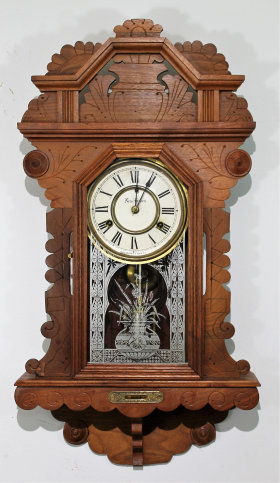
621. $1000
Seth Thomas off-center pillar & scroll, ca. 1825. A refinished case, for sure. The feet and skirt would look to be replacements, based on the stain/shellac applied to them (see the photo). Nonetheless, they
look correct. The tablet was nicely repainted by Mr. Moberg; the scroll top has been re-veneered, and the scroll tips repaired. Again, it looks good. The brass urn finials are correct to Seth Thomas style and old, with metal stems and no seams. The
dial board is adapted from another clock, and not a Seth Thomas, as it lacks the appropriate decoration below the mainstem. The old winding holes have been filled and painted over nicely, but the entire board is dark and needs cleaning. The hands
are pewter and found on some other off-center P&S clocks and so are probably correct. The wood strap movement is correct
but has had some repairs, including the fly; there is no seconds hand, but many of these clocks did not offer this. The
dial glass is very old (as is the tablet) but the putty holding it in place is new. We didn’t test the movement; the weights
are appropriate but the compounding pulleys are metal and are not original (they should be wood). There is not much of a label
left. No, this clock is not perfect by any means, but it certainly approximates the original, looks good, and is priced accordingly. These clocks have been selling for around $1500 in similar condition recently; we haven’t seen a perfect one sell in recent years
but it likely would bring quite a bit more. $1200-$1600.
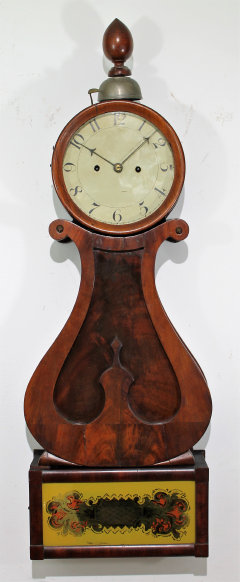
622. $2800
Early lyre banjo with bell, ca. 1830. An early unsigned lyre banjo with a bell strike on top
in a 33-inch figured mahogany case. Two weights drive the time and strike; the movement will run for a few minutes, and the
strike appears to work with a little push. The metal dial appears to hold its original paint, and the hands look original as
well. The lead weights don’t quite match, and neither do the pulleys. The pendulum assembly and weight shield may
be original, and I think the tablet with gold leaf background is original and in very nice shape. The top finial is likely a
replacement. I think there may have been a tapered base below the tablet box, as the bottom is not veneered and there are some
unexplained holes. Couldn’t find an example of this clock in Petrucelli and Sposato’s book “American Banjo Clocks”, although
similar bell strike models with similar movements are found in the early 1800’s. I found only one sale of a similar model in
the Antique Clocks Price Guide at Cottone’s in 2001 for $9625. That was a long time ago, but there just aren’t many examples
of this style of clock with the bell on top. $3500-$5000.
